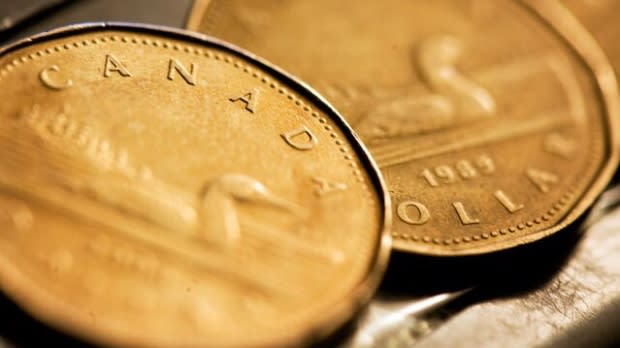TD bank predicts loonie may fall to 71 cents US as Canadian dollar's outlook shifts 'considerably'

A strong start to the year for the Canadian dollar — rising 3.5 per cent against the greenback in the first two months after a nearly eight per cent drop in value last year — had many wondering if this was the year the loonie would stage a comeback.
But, since the start of March, the Canadian dollar has fallen 1.3 per cent against the U.S. dollar as prospects for the Canadian economy have also dimmed.
Gross domestic product (GDP) contracted 0.1 per cent in January, following a deeper than anticipated slowdown that in the second half of last year.
Strategists at TD Securities say the Canadian economy has a "real problem on its hands," which will lead to broad weakness for the currency going forward.
They predict the loonie will spend much of this year in range where it will cost between $1.35 and $1.40 Canadian to buy one U.S. dollar. Put another way, that means it could dip as low as 71 cents US against the greenback. That's a more than five per cent decline from its current 75-cent level.
"Prospects for Canadian dollar have shifted considerably to the downside over the medium-term. This comes in the wake of a poor fourth quarter GDP report, and the Bank of Canada returning to the drawing board on what it got wrong," said Mazen Issa, senior foreign exchange strategist at TD securities, in a note on Friday.
"To put it bluntly, the Canadian dollar has established itself uniquely as a "problem child" in the G10. The positives are hard to find."
Issa thinks the Bank of Canada is now at the end of its tightening cycle after five interest rate hikes since mid-2017. If the central bank does move on rates this year, Issa says it will more likely be a cut.
"This dynamic should keep U.S. dollar - Canadian dollar [cross] elevated via the interest rate differential channel — especially given our view that the Fed has one last hike to deliver," Issa said, suggesting another rate hike from the U.S. Federal Reserve would further strengthen the U.S. dollar.
The probability of an interest rate hike from the Bank of Canada is at zero per cent for the next six months at least, according to trading in investments known as overnight index swaps.
"As much as the Canadian dollar is a price taker to global factors, the Bank [of Canada] can no longer ignore the fact that final domestic demand has now contracted two quarters in a row (with the fourth quarter registering a paltry -1.5 per cent)," Issa said.
"The last time this happened was in 2015. Then, the economy registered a technical recession and the bank provided "insurance cuts" due to the collapse in oil prices."
Oil and the loonie
But so far this year, the benchmark price of U.S. oil — West Texas Intermediate (WTI) —has jumped almost 29 per cent on the back of production cuts from the Organization of the Petroleum Exporting Countries (OPEC), and Canadian energy producers.
However, Stephen Brown, senior Canada economist at Capital Economics, predicts another drop in oil prices, and slow wage growth are reasons why the loonie will decline to 72 cents US this year.
"We do not expect the rebound in oil prices to be sustained. Due to a combination of weak global demand and a likely pick-up in production in the U.S., we see WTI falling back to $45 US later this year," Brown said.
"Although Alberta's production cuts have proved effective at boosting Canadian oil prices relative to U.S. benchmarks, transporting oil by rail is not financially viable at the current low discounts."
Meanwhile, Bipan Rai, head of North American foreign exchange strategy at CIBC Capital Markets, is also betting on the Canadian dollar to fall further, even though he expects the currency's correlation to oil prices to wane.
"As we've stated many times in the past, the Canadian dollar - crude oil correlation is hardly stable," Rai said in a note. "We expect the relationship to weaken in the near-term."

